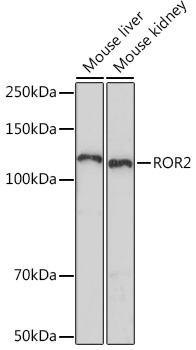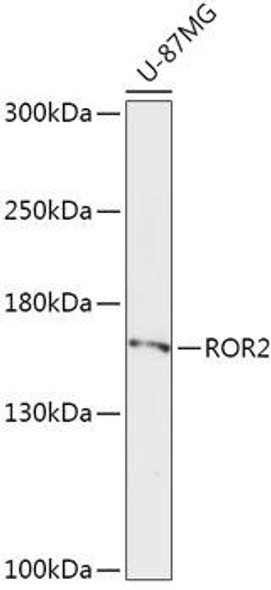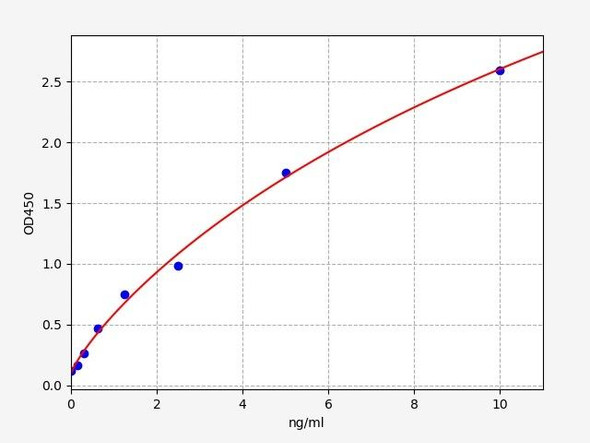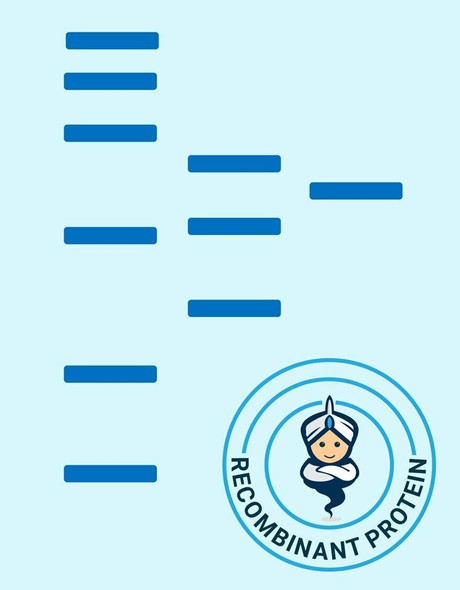Anti-ROR2 Antibody (CAB5120)
- SKU:
- CAB5120
- Product type:
- Antibody
- Reactivity:
- Mouse
- Host Species:
- Rabbit
- Isotype:
- IgG
- Research Area:
- Metabolism
Description
| Antibody Name: | Anti-ROR2 Antibody |
| Antibody SKU: | CAB5120 |
| Antibody Size: | 20uL, 50uL, 100uL |
| Application: | WB |
| Reactivity: | Mouse |
| Host Species: | Rabbit |
| Immunogen: | A synthesized peptide derived from human ROR2 |
| Application: | WB |
| Recommended Dilution: | WB 1:500 - 1:2000 |
| Reactivity: | Mouse |
| Positive Samples: | Mouse liver, Mouse kidney |
| Immunogen: | A synthesized peptide derived from human ROR2 |
| Purification Method: | Affinity purification |
| Storage Buffer: | Store at -20°C. Avoid freeze / thaw cycles. Buffer: PBS with 0.02% sodium azide, 0.05% BSA, 50% glycerol, pH7.3. |
| Isotype: | IgG |
| Sequence: | Email for sequence |
| Gene ID: | 4920 |
| Uniprot: | Q01974 |
| Cellular Location: | |
| Calculated MW: | 105kDa |
| Observed MW: | 105KDa |
| Synonyms: | BDB, BDB1, NTRKR2 |
| Background: | The protein encoded by this gene is a receptor protein tyrosine kinase and type I transmembrane protein that belongs to the ROR subfamily of cell surface receptors. The protein may be involved in the early formation of the chondrocytes and may be required for cartilage and growth plate development. Mutations in this gene can cause brachydactyly type B, a skeletal disorder characterized by hypoplasia/aplasia of distal phalanges and nails. In addition, mutations in this gene can cause the autosomal recessive form of Robinow syndrome, which is characterized by skeletal dysplasia with generalized limb bone shortening, segmental defects of the spine, brachydactyly, and a dysmorphic facial appearance. [provided by RefSeq, Jul 2008] |
| UniProt Protein Function: | ROR2: a receptor tyrosine kinase of the ROR family. May be involved in the early formation of the chondrocytes and may be required for cartilage and growth plate development. Mutations can cause brachydactyly type B, a skeletal disorder characterized by hypoplasia/aplasia of distal phalanges and nails. In addition, mutations in this gene can cause the autosomal recessive form of Robinow syndrome, which is characterized by skeletal dysplasia with generalized limb bone shortening, segmental defects of the spine, brachydactyly, and a dysmorphic facial appearance. |
| UniProt Protein Details: | Protein type:Protein kinase, TK; Membrane protein, integral; Kinase, protein; Protein kinase, tyrosine (receptor); EC 2.7.10.1; TK group; Ror family Chromosomal Location of Human Ortholog: 9q22 Cellular Component: integral to plasma membrane; plasma membrane Molecular Function:Wnt-protein binding; protein binding; frizzled binding; transmembrane receptor protein tyrosine kinase activity; ATP binding Biological Process: somitogenesis; inner ear morphogenesis; peptidyl-tyrosine phosphorylation; Wnt receptor signaling pathway, planar cell polarity pathway; multicellular organismal development; positive regulation of transcription, DNA-dependent; signal transduction; negative regulation of cell proliferation; Wnt receptor signaling pathway, calcium modulating pathway; JNK cascade; cell differentiation; transmembrane receptor protein tyrosine kinase signaling pathway; cartilage condensation; embryonic genitalia morphogenesis; positive regulation of cell migration Disease: Robinow Syndrome, Autosomal Recessive; Brachydactyly, Type B1 |
| NCBI Summary: | The protein encoded by this gene is a receptor protein tyrosine kinase and type I transmembrane protein that belongs to the ROR subfamily of cell surface receptors. The protein may be involved in the early formation of the chondrocytes and may be required for cartilage and growth plate development. Mutations in this gene can cause brachydactyly type B, a skeletal disorder characterized by hypoplasia/aplasia of distal phalanges and nails. In addition, mutations in this gene can cause the autosomal recessive form of Robinow syndrome, which is characterized by skeletal dysplasia with generalized limb bone shortening, segmental defects of the spine, brachydactyly, and a dysmorphic facial appearance. [provided by RefSeq, Jul 2008] |
| UniProt Code: | Q01974 |
| NCBI GenInfo Identifier: | 90110767 |
| NCBI Gene ID: | 4920 |
| NCBI Accession: | Q01974.2 |
| UniProt Secondary Accession: | Q01974,Q59GF5, Q5SPI5, Q9HAY7, Q9HB61, |
| UniProt Related Accession: | Q01974 |
| Molecular Weight: | 943 |
| NCBI Full Name: | Tyrosine-protein kinase transmembrane receptor ROR2 |
| NCBI Synonym Full Names: | receptor tyrosine kinase-like orphan receptor 2 |
| NCBI Official Symbol: | ROR2 |
| NCBI Official Synonym Symbols: | BDB; BDB1; NTRKR2 |
| NCBI Protein Information: | tyrosine-protein kinase transmembrane receptor ROR2; neurotrophic tyrosine kinase receptor-related 2 |
| UniProt Protein Name: | Tyrosine-protein kinase transmembrane receptor ROR2 |
| UniProt Synonym Protein Names: | Neurotrophic tyrosine kinase, receptor-related 2 |
| UniProt Gene Name: | ROR2 |
| UniProt Entry Name: | ROR2_HUMAN |









